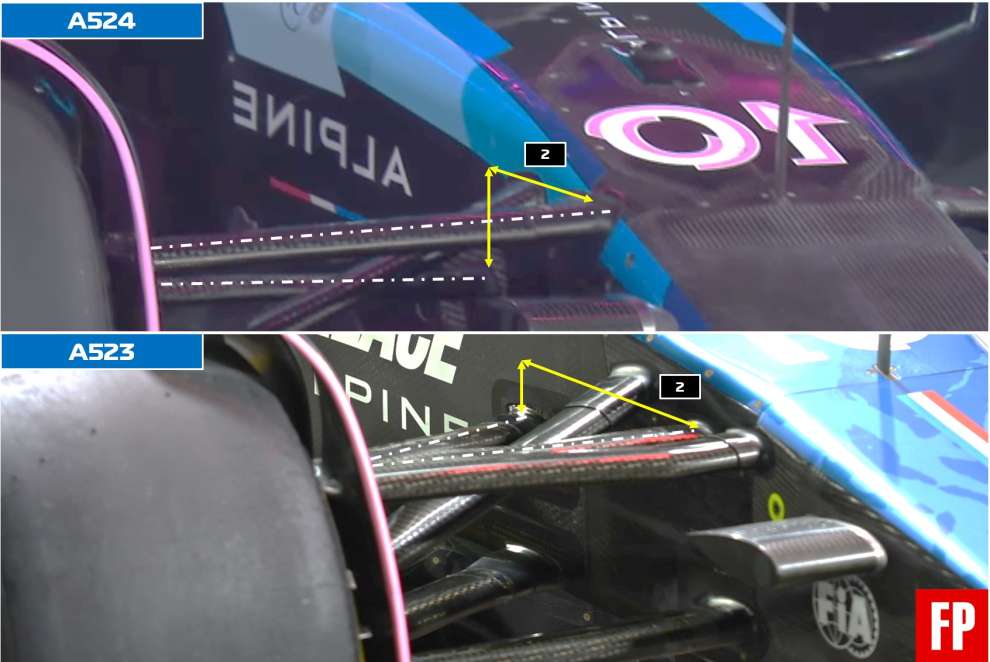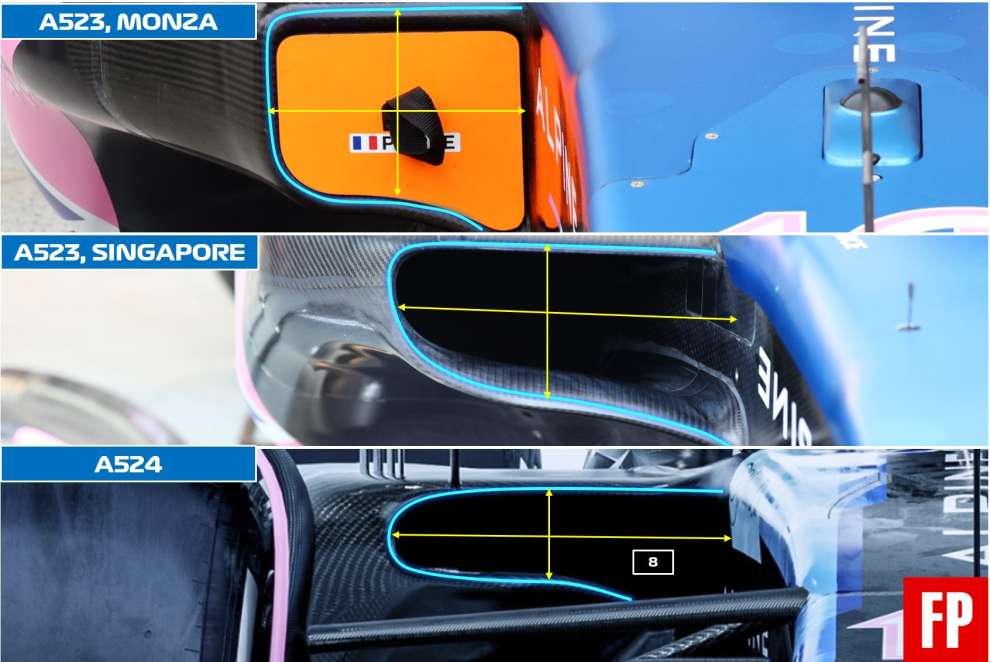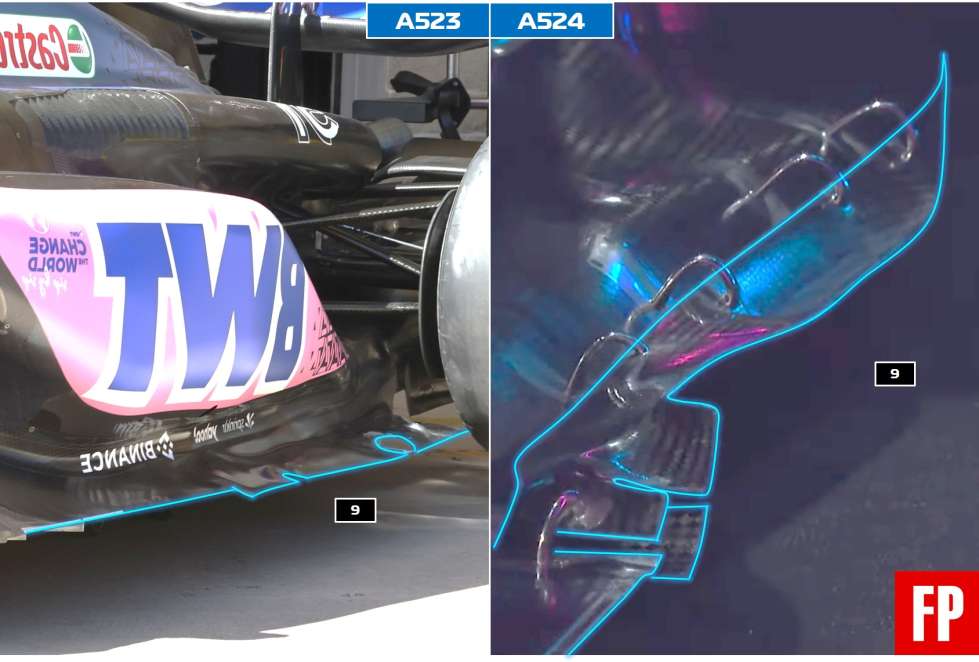By Carlo Platella
At first glance it might seem that the new Alpine differs little from the previous car, whose main limitations, even before the aerodynamic geometries, had deeper origins. The Enstone team is like this concentrated mainly on the basic platformensuring effective mechanics and housing for the power unit, which can also be proposed on the 2025 single-seater. The priority was to resolve the structural limitations of the A523, laying the foundations for an aerodynamic evolution that will take shape during the season.
Engine-chassis symbiosis
The 2023 Alpine paid for the lack of efficiency in the integration between chassis and power unit, losing both on the aerodynamic and power fronts. The engine did not enjoy optimal breathing and cooling and, not being put in the right conditions, it suffered a fair shortage of horses from the competition. At the same time, Alpine was among the teams that opened the bodywork more than any other to evacuate internal heat, sacrificing aerodynamic cleanliness and increasing resistance on the straight.
Technical director Matt Harman has been working for years for better cooperation and communication between the engine department at Viry Chatillon and the rest of the team at Enstone. The team's hope is that the A524 can reap the benefits of this reorganization. The 2024 car was born around a new frame, redesigned to favor better housing of the engine and all its internal components. The ducts and other bodywork elements are all new and promise to improve the circulation of flows under the bonnet. The goal is to reduce the cooling dragthe resistance to progress associated with the passage of cooling air under the bodywork.
By regulation, the development of the power unit is frozen at the end of 2022 specification, but this does not mean that Alpine has not tried to extract a few more horsepower. In addition to optimizing cooling, the insulation of the exhaust ducts that connect the engine to the turbine has been improved. The objective is to reduce heat dispersion from hot gases, preserving energy to better recharge the hybrid system through the MGU-H, the generator coupled to the turbo. The main exhaust duct, however, is now partially drowned inside the internal mechanics of the rear suspension. Drawing inspired by what Red Bull has done, the terminal thus has gentler curvatures and reduces pressure losses in the exhaust flow. The ultimate effect is a reduction in the work spent by the engine to pump the exiting gases, to the advantage of the useful thrust power.
Anti-dive suspension
From a size point of view, the A524 has a passenger compartment position that is very similar to the car that preceded it, without however preventing a change in weight distribution. In fact, the rethinking of the power unit packaging also includes the retraction of the battery of the hybrid system, whose minimum regulatory weight is 20 kg. The new Alpine is therefore born with a weight distribution shifted slightly more towards the rear compared to 2023, also presupposing an adjustment in the aerodynamic balance, all to improve the stability of the rear axle.
What changes and is noticeable from the outside, however, are the suspensions. Alpine now follows the Red Bull front suspension, with the exception of the push-rod scheme, confirmed from 2023 and opposed to the pull-rod of the world champions. The first change is moving the box and steering rod (1) downwards. The upper triangle, however, has a greater height difference between the front and rear arms, outlining one strong anti-pitching kinematics (2).

Also known as anti-dive, the pattern helps stabilize chassis rotation under braking, settling the floor to a more constant height and posture and reducing downforce losses. The A524 also mounts a new internal mechanics to the front suspension, seeking better control of the aerodynamic platform.

The rear suspension features the 2023 push-rod, considered advantageous both in aerodynamic terms and in terms of housing the spring-shock absorber group. Also in this case, the internal mechanics have been revised for 2024, but the most important change concerns the arrangement of the external arms. The upper triangle is now entirely set back from the push-rod rod (3) and has an offset in height between the two elements, accentuating the anti-dive pattern again. According to the technical director, the new kinematic mechanism is detrimental to the local circulation of flows, a disadvantage which however is considered more than compensated by the better stabilization of the surface.


Flattened muzzle
The presence of the physical machine in the studio allows a verification of the representativeness of the renderings, thus allowing us to also delve into considerations on the external aerodynamic surfaces. As a whole the front wing it is similar in concept to that of 2023, but still presents some corrections. The main profile, for example, now tends to lower in the center, getting closer to the ground (4). Even the distribution between the fixed and adjustable sections of the profiles is not dissimilar to the A523, while the main innovation concerns the tip of the muzzle.

From the first impact, in fact, the width and flattening of the nose (5) is striking, compared to the apparently slimmer version of 2023. This is actually a consequence of the work carried out to strengthen the front impact structure, to allow its flaring in the rearmost area. The muzzle now appears more hollow and rounded in the lower part (6), facilitating local aerodynamic management, with important benefits for the surface.

Car body
At the center of the car, the A524 continues the development path undertaken in 2023. The bodywork is still battered, transporting flows and energy towards the gearbox and diffuser environment. The lower flare under the side, also known as the undercut, is now more accentuated, taking advantage of the better packaging of the electronics and internal radiators. Furthermore, the channeling of flows under the bodywork is now more progressive, starting from a greater height thanks to the flattening of the side air intakes (7).

Already during 2023 Alpine had been increasing the aspect ratio, i.e. the ratio between the height and width of the lateral openings. Monza was the last race in which the A523 ran with square intakes, appearing in Singapore with wider and flatter openings. The same philosophy is now taken to extremes on the 2024 car (8).

As regards the Venturi Canals, at first glance there would not appear to be a different distribution in the distance between the various strips. Even the outermost bulkhead does not differ from that of 2023, except for the beveling of the upper vertex.


The most important aerodynamic renewal concerns the external edge of the bottom, a crucial area for performance, both extracting flows laterally and protecting the bottom against external turbulence. On the A524 the edge is now noticeably more elaborate, with forts references to the solutions proposed by Red Bull (9).

Overall, Alpine shows that it wants to develop the aerodynamic concept already explored in 2023, while laying a more stable foundation. The new suspensions will be an important help in stabilizing the surface, especially in the braking and traction phases. The packaging work of the power unit, however, will be invaluable for gain km/h on the straight, both thanks to the lower aerodynamic cooling resistance and to the gain of a few horsepower. The A524 is called upon to perform better than those expressed at the end of 2023, also considering that Williams and the ex-AlphaTauri will not stand by and watch.
#Alpine #technical #analysis #transformation #hood